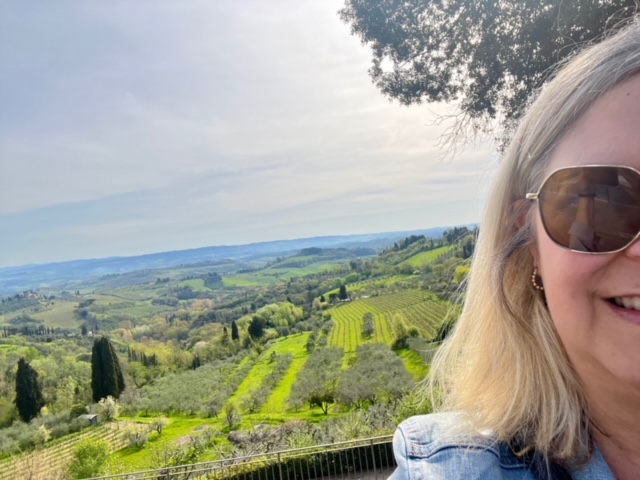Day 2 in Tuscany
After enjoying breakfast on day 2 (see day 1 here), we set off in our little T-Cross for San Gimignano. The drive was just beautiful, and Kevin wished for a zippy sports car for zooming around all the curves. Our navigation program took us right there with no wrong turns!
Tip for driving in Italy: You can't drive into the historic centers of the towns. If you do, you'll get a hefty fine. So, when setting out to visit one, scout out ahead of time where you will park. They've all got parking lots nearby, marked with blue signs with a white P. A few might be free, but most require payment, and the process for paying it varies from lot to lot.
As we walked from the parking lot into the town, we were greeted with these beautiful views of the Tuscan hills.
We were hoping to beat the tourist buses, but even by around 10:00 on a Sunday in early April, there were lots of people. San Gimignano is a medieval town that is known for its many towers. 14 of the original 72 (!) are still standing. There's a cathedral you can visit, and one of the towers is open for climbing. In the town square, the old cistern is still there. We walked around, took lots of pictures, stepped into some shops, and ultimately set up camp at an outdoor table with a drink and a snacky lunch.
By this point, the crowds were increasing, and we were ready to move on. When we left the parking lot, we just assumed that we'd insert the card we'd gotten into the machine at the gate. But, that didn't work. Finally, we used our Google translate app to learn that we were supposed to have paid at a booth back up in the parking lot. OOOHH. Fortunately, there wasn't a car behind us, so we backed up and found the little payment shelter. We had thought it was a bus stop.
After we escaped the parking lot, we set our navigation for the start of this trail- the Diboratto Waterfall in Colle Val d'Elsa. We found free parking nearby at an athletic field where there was a rugby game underway.
We did not do the entire trail. We walked the first mile, then turned back. But it was just beautiful! There were wildflowers blooming, and the water was a gorgeous aqua blue. The trail itself wasn't crowded, but lots of people were out enjoying the warm weather (mid 70s) and swimming, picnicking, and just hanging out. All Trails called this an easy hike, but the trail is rocky and there are places where you have to ford across on rocks. I saw several older people using trekking poles, and I wished I had mine. I was glad to have my Merrells on while trying to navigate the rocks. It was definitely worth finding space for them in my suitcase. Don't listen to the young'uns who say not to pack hiking shoes, especially if, like me, you're no mountain goat.
From Colle Val d'Elsa, we drove to Volterra. The parking there was a "pay and display" type. You had to go to a little machine as soon as you parked and pay to get a ticket to display. Kevin struggled with it until he finally just downloaded the app for that parking vendor and used the app.
Volterra is known for its Etruscan origins, and for the handmade alabaster objects made there. We passed through the historic gates, stopped into several stores, got some gelato, and visited one of the beautiful churches and the Etruscan museum. The museum was very interesting, and contrary to what the article I linked to above says, there were explanations in English for everything. I was very amused to see a resident's laundry hanging on a line outside of their window through the window of the museum's grand staircase. There, framed nicely in a beautiful Palladian window, was the resident's floral tablecloth, a shirt or two, and a bra. Clothes dryers are not common in Europe, and especially not in small villages, so we saw laundry hanging out to dry everywhere we went.
The drive back to Castello di Fonterutoli was about an hour. We changed out of our hiking pants and shoes (lightweight hiking pants make GREAT travel pants!) and freshened up a bit before heading 5 minutes away to the little town of Castellina in Chianti and the Osteria Rosticceria Il Re Gallo - The Rooster King. The black rooster is a symbol of the Chianti region as a result of this story: In the medieval period, Florence and Siena disputed their territory with each other, and so they decided to send a knight from each city to meet in the middle. Wherever they met would be the boundary of each respective region. They were to set out at the rooster's first crow. The knight from Siena chose a fat white rooster but the Florentine knight chose an underfed black rooster. The hungry rooster woke up first and this gave the Florentine knight a headstart. He made it all the way to Fonterutoli, just 12 km short of Siena, and this meant that Florence controlled most of the Chianti region.
We had a very nice meal at The Rooster King, starting with some Italian coldcuts and cheeses, and continuing with pasta and a rabbit ragu. Wild game such as venison and boar is traditional Tuscan fare, but this was my first time eating rabbit! We split a bottle of wine from the Mazzei winery and finished with Tiramisu. I love Tiramisu, but I especially love Tiramisu in Italy.
We walked 10 miles on our first full day in Tuscany. We slept hard in our charming, peaceful room.
















Comments
Post a Comment